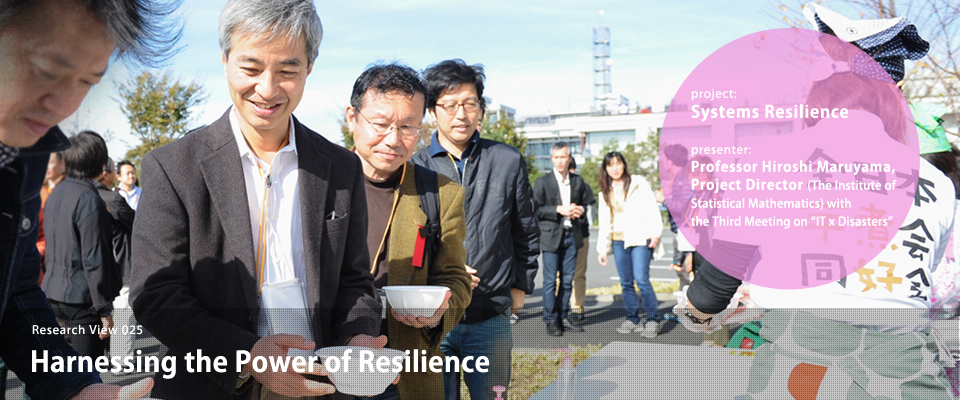
Prof. Hiroshi Maruyama of the Institute of Statistical Mathematics has led our organization's research project, “Systems Resilience," for four years. Ahead of the end of the project in March 2016, it co-hosted the third conference on “IT x Disasters,” an informal get-together of IT engineers who are interested in volunteering their skills in disaster relief. The organizer of the conference was looking for new collaborators, and Prof. Maruyama saw it as a great opportunity to deepening the resilience theme by meeting with people who have various field experiences, and decided to join the event. Let's see how the idea worked.
A network of people is essential for planning disaster mitigation
At this event, the highlights of the project on “Systems Resilience” were presented in various forms such as speeches, posters, and talk sessions. There were also reports and recommendations from the participants, and as expected, the importance of a human network often became a topic of conversations. In fact, the concept of human network is very close to what we consider the essence of resilience and illustrates the compatibility of diversity and altruism. Prof. Maruyama thinks this jointly sponsored event was a meaningful opportunity to analyze resilience using concrete examples, which was one of the original goals of the project.

The Shonan Meeting, where the world's knowledge on resilience converged
How do researchers around the world approach the theme of resilience? Earlier researches focused mostly on ecological and environmental systems. A mathematical model called system dynamics was a favored tool to analyze and model system behavior in question. Countries with geopolitical fragility such as like Singapore and Finland have a lot of activities in resilience research. In order to bring together the knowledge on resilience, we conducted a five-day intensive workshop on systems resilience in February 2015 at Shonan Village Center, an isolated conferencing facility situated on a hilltop with beautiful sights of Mt. Fuji. The workshop covered a wide range of discussions, among which was a realization that when a system receives a large shock, sometimes it is impossible to save the system without saving entities that are external to the system, for example, neighboring cities (when saving a city) or supply chain (when saving a company). In other words, when a crisis occurs that cannot be dealt with in a single system, its boundary may need to be reconsidered. We agreed to call this spillover effect a “boundary leakage.”

Unraveling the social effects at the Thailand floods
The project on “Systems Resilience” employed an inductive approach to collect facts on various forms of resilience, analyze commonalities and differences among them, and build a taxonomy, as well as a deductive approach, starting from an abstract model of resilience and drawing mathematical properties from it. One example of the former approach, done by the team headed by Associate Professor Hitoshi Okada (the National Institute of Informatics), is on how people’s perception affects the resilience of a society. Using the twitter data at the time of the Thailand flood in 2011, his team demonstrates how mood changes over time, as the people’s confidence on their government gradually deteriorated, and how this mood change affected the overall resilience of the society.

Learning from biology -- Understanding the correlation between diversity and the law of diminishing returns
In the second approach, Professor Hiroshi Akashi (the National Institute of Genetics) is working on a mathematical model of gene mutations in terms of fitness to an environment. His theory is that, if the fitness function is concave, meaning that multiple advantageous mutations are combined, the additional advantage of a new mutation becomes smaller and smaller – a property sometimes called the law of diminishing returns. His model suggests that, under the assumption that the fitness function exhibits the law of diminishing returns, the resulting population has a larger diversity, which is believed to be one of the major factors that enabled the life on the earth to have survived more than 4 billion years. This discovery may be applicable to designs of systems in different domains, which make the systems more diverse and thus, more resilient.

(Text in Japanese: Hiroshi Maruyama, Rue Ikeya. Photographs: ERIC. Published: November 30, 2015)







